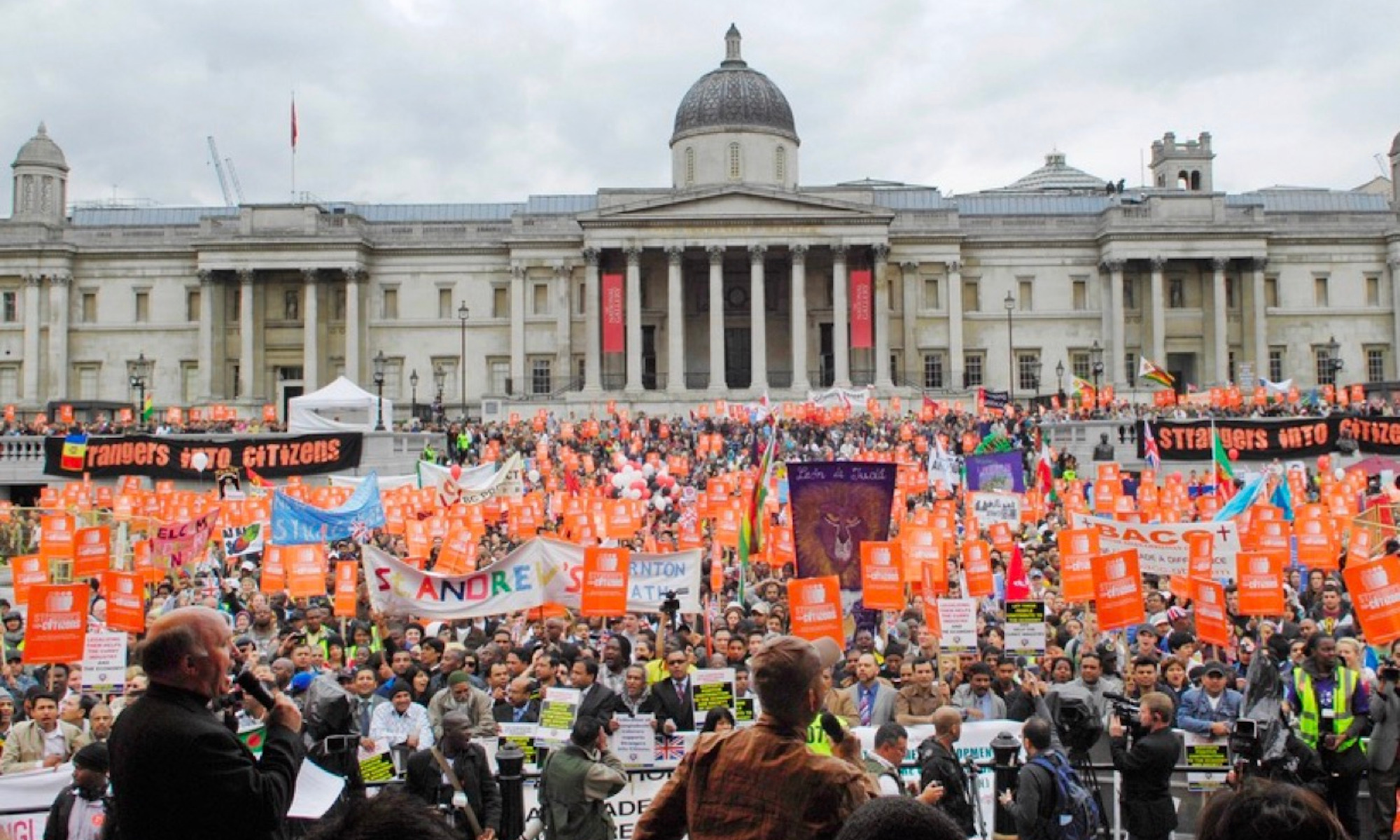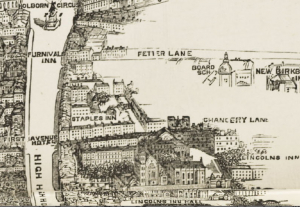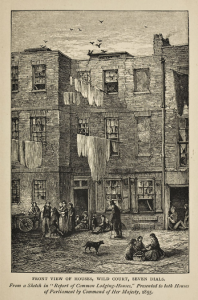In Dickens’ Oliver Twist, Oliver descends into the world of criminals when the Artful Dodger introduces him to Fagin. Throughout the novel, Oliver is led across London by these criminals as they attempt to initiate him into a life of crime. Oliver’s migration around the city implicates the entire city as bystanders to his unjust treatment, thus placing London itself on trial. In this trial, London is charged with an indictment of injustice against a migrant child in need. Evidence of the city’s guilt emerges from a variety of sources: mob justice, the court system, and the policing system all fail to provide the migrant child with aid. Thus, by the end of the trial, there is little choice but to find London guilty of all charges.
The mob justice system is an incredibly potent force in the novel. It often acts as the first level of law enforcement before officers can arrive on the scene. This is especially evident in the passage where Oliver is chased by an angry mob after he is falsely accused of stealing a handkerchief. Here, Dickens writes of the pursuit:
“’Stop thief! Stop thief!’ There is a passion for hunting, something deeply implanted in the human breast. One wretched
breathless child, panting with exhaustion; terror in his looks;
agony in his eyes; large drops of perspiration streaming down
his face; strains every nerve to make head upon his pursuers; and
as they follow on his track, and gain upon him every instant,
they hail his decreasing strength with joy.” – Oliver Twist, Chapter 10
Oliver’s pursuers are not drawn into the chase because they’re concerned with the proper execution of justice; rather, they are enthralled by the thrill of the hunt. The language in this passage is so powerfully evocative of a predatory pack that the word ‘child’ can easily be replaced with the word ‘deer’. Dickens’ portrayal of the “attraction of repulsion” comes from a history of observing the attitudes of London bystanders in relation to capital punishment. In February 1946, Dickens wrote a letter about his experiences at Courvoisier’s hanging in 1840. He remarked that among the entire crowd he saw “no sorrow, no salutary terror, no abhorrence, no seriousness; nothing but ribaldry, debauchery, levity, drunkenness, and flaunting vice in fifty other shapes.” He further goes on to say “I should have deemed it impossible that I could have ever felt any large assemblage of my fellow-creatures to be so odious” (Horne). Dickens is repulsed by their lack of repulsion, a sentiment that emerges clearly in his references to mob justice carried out on an innocent child. He continues with this theme in the second instance Oliver is placed at the mercy of the crowd: when he is being kidnapped from Pentonville.
When Mr. Brownlow sends Oliver on a task to return some books to the book-stall in Clerkenwell, Nancy captures the boy by pretending he is her runaway brother. Despite Oliver’s protests, all of the looker-ons refused to believe him. Rather, they encouraged his kidnappers, even when Bill Sikes used violence:
“With these words, the man tore the volumes from
his grasp, and struck him on the head.
‘That’s right!’ cried a looker-on, from a garret-window. ‘That’s
the only way of bringing him to his senses!’
‘To be sure!’ cried a sleepy-faced carpenter, casting an
approving look at the garret-window.
‘It’ll do him good!’ said the two women.” –Oliver Twist, Chapter 15
Just as in the Clerkenwell mob, the crowd is unified by their approbation of punishment despite a lack of evidence proving the child’s guilt. There seems to be something about Oliver that makes him appear particularly culpable to the public eye. From the very beginning of his life, Oliver is classified as a ruffian. When Oliver was named by Mr. Bumble, he was given the last name “Twist”. “Twisted” was one of the slang words for “hanged” at the time, referring to the way one twisted as they swung on the rope (Horne). By giving Oliver this name, Mr. Bumble lays out his expectations for a young child born in poverty, as well as that of London society. Criminals were often sentenced to death by hanging, especially thieves. The Londoners predict that a child like Oliver is bound for the same fate. Nothing Oliver says seems to be enough to convince the crowd of his innocence, so much so that “overpowered by the conviction of the bystanders that he really was the hardened little wretch he was described to be” (ch. 10), Oliver gives up resistance.
Societal expectations for the migrant, impoverished child are not only evident in the city’s common crowd, but also in its court system. Oliver is shown no mercy by the judge, even when evidence against his involvement in the crime is produced by the officer. At the trial, the policeman gives his account of the events:
“The policeman, with becoming humility, related how
he had taken the charge; how he had searched Oliver, and
found nothing on his person; and how that was all he knew
about it. ‘Are there any witnesses?’ inquired Mr. Fang. ‘None,
your worship,’ replied the policeman.” – Oliver Twist, Chapter 11
Oliver is found innocent of the crime that he is charged with; however, he is still treated like a criminal. Right after receiving this evidence, the justice calls Oliver a young vagabond, branding him with the title of a criminal simply because Mr. Brownlow assumed Oliver to be connected with the thieves that had performed the crime. Moreover, the court dismisses the fear and illness of the boy, even when he faints in the courtroom:
“’I think he really is ill, your worship,’ remonstrated the
officer.
‘I know better,’ said Mr. Fang.
‘Take care of him, officer,’ said the old gentleman, raising his
hands instinctively; ‘he’ll fall down.’
‘Stand away, officer,’ cried Fang; ‘let him, if he likes.’
Oliver availed himself of the kind permission, and fell to the
floor in a fainting fit. The men in the office looked at each
other, but no one dared to stir.
‘I knew he was shamming,’ said Fang, as if this were
incontestable proof of the fact. ‘Let him lie there; he’ll soon
be tired of that.’” – Oliver Twist, Chapter 11
In the eyes of the court, Oliver didn’t deserve the kindness that would normally be shown to a child of his age on account of his possible association with criminality. Childhood is a social construct; who is perceived as a child varies between cultures, hence, the concept of child innocence also carries a sort of ambivalence. There is an ignorance expected of children at a certain age that makes it unreasonable to accuse them of a crime. Legally, in 19th century London, this age only extended as far as seven years old. Any child older than this would have to prove their innocence before a court of law. Oliver, who is older than seven when he is placed before the court, is not guaranteed protection because of his age. He is tried as any adult would be in a court of law, and unfairly. Hence, he is given a sentence of 3 months’ hard labor as he lays unconscious on the floor of the courtroom. Dickens’ juxtaposition of judgement and vulnerability in Oliver Twist emphasizes the city’s black and white approach to justice. In the robbery at Chertsey this juxtaposition resurfaces, demonstrating the importance of this idea in identifying the problems with London law enforcement.
Bill Sikes takes Oliver to Chertsey to break into the home of Mrs. Maylie and let the robbers inside. Oliver attempts to warn the family as soon as he enters the house, but in the process he gets shot in the arm. Abandoned by the robbers, Oliver is left with no choice but to crawl to the Maylie’s door and beg for assistance. When the child has begun to recover, he divulges his entire story to the doctor and Rose Maylie. Yet, even this does not seem to free Oliver in the eyes of the law. The doctor and Rose discuss Oliver’s predicament in this passage:
‘Surely,’ said Rose, ‘the poor child’s story, faithfully
repeated to these men, will be sufficient to exonerate him.’
‘I doubt it, my dear young lady,’ said the doctor, shaking
his head. ‘I don’t think it would exonerate him, either with
them, page or with legal functionaries of a higher grade.
What is he, after all, they would say? A runaway. Judged by
mere worldly considerations and probabilities,
his story is a very doubtful one.’ – Oliver Twist, Chapter 31
In the end, to prevent his arrest, the boy’s supporters have no choice but to cast doubt on the claim that Oliver was the same child who broke in through the window. The doctor firmly believed that if they had told the truth, Oliver could still be arrested while he was on the brink of death. This cold-hearted approach to justice appears to be an intense dramatization of a rather small crime. Indeed, Wolff speculates ‘if Dickens indulges in some displacement of affect, charging the issue of theft with the highest literary energy, it is because there may be more at stake than stealing. For Dickens himself theft was the first term, and the only criminally specific term, in a series that culminated in “all that’s bad.”’ Oliver Twist isn’t a novel about a child struggling against becoming a thief; rather, it is a novel about a child battling against total moral corruption. Hence, the punishment for becoming a thief, a choice that is comparative to becoming all that is evil, is most severe. However, Oliver wasn’t a thief, nor the willing associate of thieves. He was a sickly, weak, and wounded child. The fact that his story would not be accepted by London’s enforcers of justice is one of the greatest injustices in the novel. Indeed, a punishment so severe for a child so innocent threatens the very meaning of justice itself. Chertsey’s law enforcement, just like the law enforcement in other parts of the city, has failed Oliver.
In conclusion, Oliver Twist is a story that follows a migrant child and his struggle against the injustice of the city of London. London fails to prove Oliver’s guilt through a fair trial and questioning, instead assuming his criminality from the start; it fails to help him when his life is in danger; finally, it fails to believe him when he attempts to show his innocence. London is guilty of grave injustice to the migrant child; it is only through the kindness of individuals that Oliver is saved in the end.
Works Cited:
Dickens, Charles. Oliver Twist. Leigh Little.
Wolff, Larry. “”The Boys are Pickpockets, and the Girl is a Prostitute”: Gender and Juvenile Criminality in Early Victorian England from Oliver Twist to London Labour.” New Literary History, vol. 27 no. 2, 1996, p. 227-249. Project MUSE, doi:10.1353/nlh.1996.0029.
Horne, Phillip. “Crime in Oliver Twist”. British Library. 15 May 2017. https://www.bl.uk/romantics-and-victorians/articles/crime-in-oliver-twist#. Accessed 3 May 2021.











 I’ve been told all my life that I’m a minimalist, and although I find that to be a little extreme, it’s more or less true. So long as I’m well-fed, safe, and have comfy clothes, I am quite content. So, when I was told I would be relocating to Redmond for my internship, I didn’t give it any thought. I wanted to intern at Microsoft, it was in Redmond, so I was in Redmond.
I’ve been told all my life that I’m a minimalist, and although I find that to be a little extreme, it’s more or less true. So long as I’m well-fed, safe, and have comfy clothes, I am quite content. So, when I was told I would be relocating to Redmond for my internship, I didn’t give it any thought. I wanted to intern at Microsoft, it was in Redmond, so I was in Redmond.